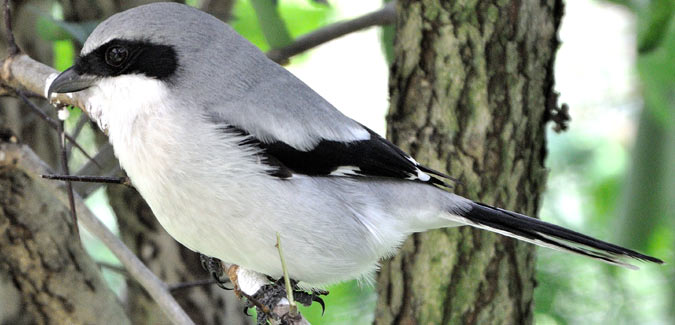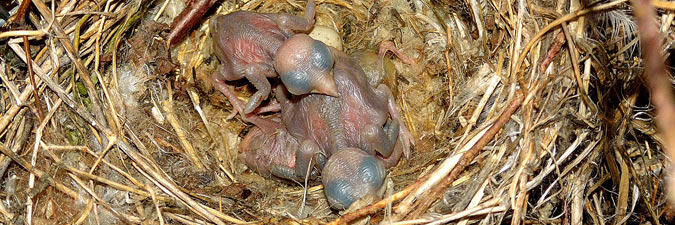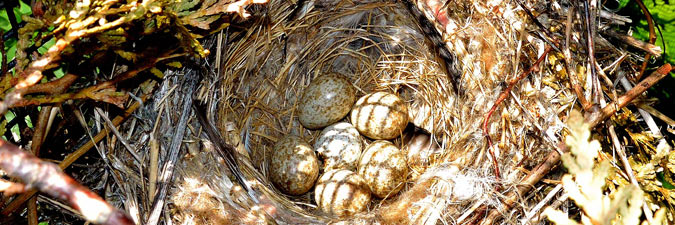Eastern Loggerhead Shrike Captive Breeding
The shrikes (Family: Laniidae) are a unique group of songbirds because they hunt like birds of prey. They have sharp hooked beaks, but lack the strong grasping legs possessed by true birds of prey. Instead, shrikes will impale their prey on thorns or barbed wire fences, which allows them to tear apart and eat their prey. Sometimes shrikes will leave impaled prey items as a ‘cache’ to be consumed later or a territorial marker. The loggerhead shrike (Lanius ludovicianus) is the only endemic shrike in North America.

The eastern subspecies of the loggerhead shrike (Lanius ludovicianus ssp.) is one of the most imperiled birds in North America. In Canada, loggerhead shrikes are now only found in a few isolated pockets of grasslands in Ontario, Quebec, and Manitoba. They used to be found readily from southwestern Manitoba, east to the Maritime Provinces.
In 1991, in response to a rapidly declining population, the Committee on the Status of Wildlife in Canada (COSEWIC) listed the eastern loggerhead shrike as endangered, and it is now protected by provincial endangered species legislation in Ontario, Manitoba, and Quebec. In 1992, a Loggerhead Shrike Recovery Team was formed and recovery plans were produced by 1994. In 1997, when only 100 eastern loggerhead shrikes were estimated to remain in all of Canada and a mere 18 pairs could be found in Ontario, Environment Canada established a captive population to ensure that the unique genetic material of these birds would be preserved. Between 1997 and 1998, 43 young birds were brought into captivity and the first captive breeding followed shortly thereafter. The Toronto Zoo has been involved in the captive breeding of eastern loggerhead shrikes since the program’s inception and have hatched well over 100 chicks.

In 2001, the program expanded to include an experimental field breeding and release program, with three pairs being placed in field propagation cages and 10 young released into the wild. The program has expanded considerably since then, with approximately 100 young being produced annually between 2006 and 2010, the majority of which were released into the wild. Released birds have demonstrated the ability to migrate and return to breed in subsequent years, successfully contributing to the wild population. Breeding pairs are infrequently found in Manitoba. In 2010, the first breeding pair in 15 years was found in western Quebec.
Loss of suitable grassland habitat and degradation in both the breeding and wintering grounds are the greatest threat to eastern loggerhead shrikes, but the rate of their population decline appears to be greater than the rate of habitat loss. This suggests that other threats may be involved as well. Motor vehicles are one factor that could be involved in their decline since shrikes like to perch on fence and utility lines along roadways, and sometimes collide with passing vehicles. The use of pesticides may also be a factor. Also, conditions or changes to their migration routes may be having an effect on the number of birds that are able to return to Canada from their wintering grounds in the southern United States.

Habitat improvement projects began in 2001 and approximately, 12,000 acres of shrike habitat on private lands in Ontario, Quebec, and Manitoba have been restored, enhanced, or protected. In this capacity, the eastern loggerhead shrike serves as an important flagship species since its protection also results in protection for the countless other species that share this habitat. With continued captive breeding and habitat improvements, it is hoped that the number of eastern loggerhead shrikes released each year will continue to increase and that the wild population will become sustainable once again.
Eastern Loggerhead Shrike Program Partners
African Lion Safari
Bird Studies Canada
Canadian Wildlife Service
Conservation Halton – Mountsberg Conservation Area
Couchiching Conservancy
Little Ray's Reptile Zoo
Ministry of Natural Resources and Forestry (MNRF)
National Zoo - Smithsonian Conservation Biology Institute
Nature Conservancy of Canada
Ontario Parks
Ontario Veterinary College
Queen's University
Wildlife Preservation Canada
York University













